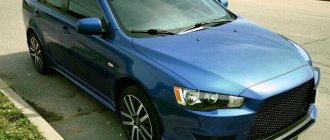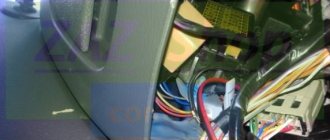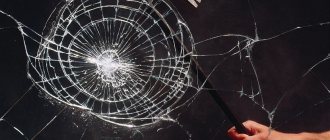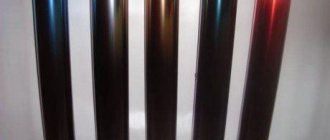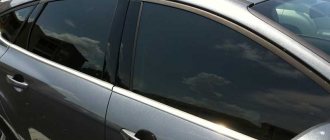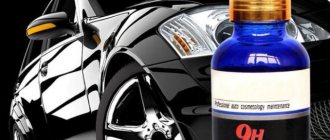A crack or chip in the windshield is an unpleasant moment for every motorist, because driving with damaged glass becomes unsafe due to glare. In addition, the crack may become larger over time and in this case only replacement will help. Fortunately, new technologies are being created and windshield repair is possible. There are several effective ways to fix chips or cracks on your windshield yourself at a minimum cost. Read more about how to repair a windshield, and will be discussed in this article.
DIY windshield repair
Causes of glass damage
Damage to the windshield can be caused by various factors, ranging from mechanical damage or an accident to severe hypothermia in summer weather. But most often, defects on auto glass appear for the following reasons.
Sudden changes in temperature
Some inexperienced motorists get rid of ice on windows using boiling water, which leads to cracks. Also, such defects can occur when the element is severely overcooled in hot weather. To prevent such troubles, you need to avoid sudden temperature changes.
Glass cracked due to temperature
Body deformation
Deformation can be caused by fast driving on uneven roads, poor-quality body repairs, or the consequences of minor accidents. All this will sooner or later lead to the appearance of defects on the windshield.
Minor deformation of the car body
Articles on the topic
Do-it-yourself headlight polishing
How to remove rust from a car body
Small objects hit
Quite often, various objects (crushed stone, gravel or spikes) fly out from under the wheels of cars. At high speed, they can damage the car’s paintwork or, if a stone hits the windshield, cause “bugs” to appear.
Pebbles hit the windshield
How to protect your windshield from chips: preventive measures
To prevent further damage, the following measures are recommended:
- deflector for hood;
- glass film armoring;
- careful driving.
The use of a deflector is dangerous due to damage to the hood paint by metal fasteners during installation and operation.
Films are designed to protect against external influences: dust, dirt, water, stones, etc. Thus, armoring the windshield with a special film can protect the surface from damage for a long time. The disadvantage of the method is that the density of the material from which the film is made is not sufficient to withstand the continuous impact of wipers and small particles of sand. Over time, the protective film becomes scratched and will require replacement.
To avoid damage to the windshield when driving, make it a rule:
- drive carefully;
- maintain the required distance from the vehicle ahead;
- do not press against trucks;
- Reduce speed before gravel areas;
- In front of large oncoming traffic, reduce your speed and move as close to the right side as possible.
Diagnostic features
Even if minor damage appears on the glass, you should not panic right away. This can all be repaired. Of course, the effectiveness of repair largely depends on the size of the crack or chip, so diagnostics are initially needed. Inspect the defect and assess the damaged area to assess the plan for further work.
Windshield diagnostics
If the crack is single, then you can deal with it yourself , without resorting to the help of specialists. But if there is multiple damage, then you need to consult a specialist. It is likely that restoring such glass will cost much more than replacing it. Once the decision to repair has been made, you can begin the preparatory stage.
Inspection of a crack in the windshield
A thousand stones, bastards! Is there a chance to “fix” the windshield?
Pop - and after being hit by a stone from under the truck in front, a chip appeared on the glass. What should I do to prevent cracks from spreading in all directions and the glass not having to be replaced? Don't delay your visit to the specialists! But first, find some tape...
We once looked at the archives of the newspaper “Avtobusiness” , which are stored in the editorial closets, and looked through the folders on our work computers: how much has been done and written, wow! I can't even believe it! Why not remember previous publications? Moreover, many of them are useful and relevant to this day. We will mark archived articles with a special icon. We hope you will enjoy reading them on these warm summer evenings as much as we do.
"Bull's eye", "asterisk" and the feasibility of repair
Have you seen such a small mark from a stone, as in the photo? Such mechanical damage is not considered chips. This is a broken glass, which is not fraught with anything and does not need repair.
Chips are a completely different matter. The most complex and dangerous of them is the so-called “star”, from which many rays diverge, and each one can turn into a crack. Both the chip itself and the rays require repair. And its feasibility depends on the amount of work and the materials required for this. Repair makes sense if, according to preliminary estimates, the “treatment” will cost no more than 1/3 of the cost of replacing the glass.
If a bull's eye appears from a stone strike, consider yourself lucky: if there is no combination of microcracks, then this type of damage will most likely not spread further. But it still needs to be repaired, otherwise there will be access for moisture, which, when frozen in winter, will have a destructive effect.
There are also so-called combined chips - they look like a “bull’s eye”, from which small rays diverge. With timely treatment and high-quality repairs, the development of cracks can be avoided.
The technology is the same - differences in equipment
Repairing the damaged area takes from 20 to 40 minutes and looks like this. First, the repair site is cleaned, the center of the chip or the edge of the crack is drilled out. This, on the one hand, relieves stress from this area of glass, on the other hand, it facilitates the penetration of the polymer, which is poured into the chip or crack using an injector - a kind of syringe that creates the necessary pressure to supply the polymer to the area being repaired. The technology involves the use of different compositions that differ in viscosity: first, the “base” is poured, then the “sealing” layer of increased density. After pouring, the polymer is “dried” with an ultraviolet lamp, its excess is removed, and the repair area is ground to eliminate large roughnesses and surface scratches.
To make the repair as unnoticeable as possible, polymers are matched to the color of the glass. However, a complete match of shades is not always possible, and then the repaired areas will look like dots/blotches of different colors. In any case, you should not expect that the repaired glass will look like new - at some angle the chip or crack will still be visible.
Price issue
Of course, the final cost depends on the type of damage and its size. The logic is clear: the larger the size, the more materials are consumed, and, accordingly, the higher the cost of repairs.
We have updated prices, and today fixing a crack costs about 0.9 -1.5 rubles. for 1 cm, stopping a crack - 6-15 rubles, repairing a chip - 12-20 rubles.
There are nuances
Only triplex can be repaired, which, let us remind you, consists of outer and inner layers and a film between them. Only the outer layer is repaired. If the internal one is damaged, the glass is replaced.
The lower part of the glass is subject to greater temperature changes than the upper - this is how the flow of warm air from the “stove” is directed, and the heating filaments are located there in the rest zone of the windshield wiper blades. Therefore, if the glass is damaged in the lower part, the likelihood of cracks appearing is higher, and they grow faster.
If the entire glass is heated, then when drilling holes there is a risk of damaging the conductive thread - the heating will not work in this place. All craftsmen agree that if the glass is not repaired in time and heating is used, the crack may increase due to temperature changes. But as to whether it is possible to use heating after repairs, there are different assessments: some experts say that this is undesirable, others claim that there will be no negative consequences.
About the result and guarantees
The success of the repair largely depends on the actions of the car owner. As soon as a chip appears, the damaged area must be sealed with tape or other available material (at worst, with a plaster from the first aid kit). It is important to prevent water and dirt from getting inside: moisture can be evaporated, but impurities cannot. And the sooner a motorist turns to repairmen, the better, and the count is in days, not months, because due to vibrations and temperature changes, even a small chip can lead to the appearance of a crack, the size of which will grow.
As for the damage itself, small chips, especially the bull's eye type, are repaired successfully. It’s a little more complicated with “stars” and cracks - here the possibility and feasibility of repairs depends on their size. If there are many rays diverging from the chip or the length of the cracks exceeds 10 cm, you should carefully weigh the pros and cons. Well, if the cracks are more than 20 cm in length, you will probably be advised to replace the glass.
Despite the fact that under the above conditions (quick handling, minor damage) the chances of a successful repair are very high, and in the future the glass will be able to last for more than one year, the craftsmen do not give real guarantees for their work. The reasoning is as follows: the integrity of the glass is still compromised, and the glued glass of modern cars also has a load-bearing function, affecting the rigidity of the body, and therefore experiences serious loads. In general, no one can guarantee that after repairs the cracks will not continue to grow or the glass will burst.
Our verdict
Small cracks and chips can and should be “treated”: the sooner you contact the experts, the higher the chances of a successful repair, although be prepared for the fact that they will not give you any guarantees. With larger damages it is more difficult, since the feasibility of repair will depend not only on their type, but also on the ratio of the cost of solving the problem and the cost of new glass, and here everything is individual.
Extend the life of glass
While cash-strapped Belarusians drive with cobwebs on their windows until the last moment, in the West the service life of a windshield on average does not exceed 5 years. Replacement may be necessary not only because of cracks: over time, bruises from small stones and sand, small chips, and abrasions from windshield wipers appear. It makes no sense to eliminate these defects: in order to avoid lens effects, the glass would have to be polished to the depth of these defects over the entire surface, and this is not cheap.
Therefore, if you want to extend the life of your windshield, do not allow the wipers to work dry and treat the glass with “anti-rain” (then the brushes themselves will have to be turned on less often, and they will glide across the glass more easily). Also avoid sudden temperature changes: do not suddenly direct cold air from the air conditioner in the heat and, conversely, do not test the glass for strength with a “stove” in the cold (the temperature change should be gradual).
Ivan KRISHKEVICH ABW.BY Photo by the author and avtomobilisty.com, autoorsha.com, jetta-club.org
What is needed for repair
To eliminate chips and cracks on the windshield, you need to prepare a minimum of repairs. What is included in this repair minimum is described in the table below.
Table. Automotive glass repair equipment.
| Inventory, photo | Description |
| Flashlight and mirror | Needed to identify possible air bubbles in the polymer. You can also use a flashlight to determine the boundaries of the damaged area. |
| Bridge and injector | Designed for introducing optical glue onto a damaged surface. It is advisable to use a metal bridge, since they have no restrictions on the period of use. |
| Scriber | A special tool used to expand the damaged area. Also, using a scriber, the glass is cleared of tiny fragments. |
| Ultraviolet lamp | An ultraviolet lamp is used to accelerate the hardening process of the polymer. It makes auto glass repairs much faster. |
| Drill | An electric drill is needed to drill holes along the edges of the cracks. Along with the drill, you also need a diamond drill. |
| Liquid polymer | Glue with a short drying time is excellent for repairs. The polymer must be transparent, just like glass. |
Note! To treat glass, you need cleaning fluid and wipes. Without pre-treatment of the glass, the polymer will not be able to strengthen sufficiently.
Windshield repair
There are several important conditions when repairing a windshield. First of all, you need to make sure the quality of the polymer used. The fact is that not all products from well-known manufacturers are suitable for our harsh climate. But as soon as everything is at hand, you can start working. The processes for repairing chips and cracks separately are described below.
Repairing a chip on the windshield
It is worth noting that repairing chips is much easier than eliminating cracks. Moreover, you can buy special tools for repairs in auto stores. Below step-by-step instructions describe the repair process in detail.
Step 1. To work, you will need a special kit for repairing windshield defects. You can purchase such a set at any auto store.
Windshield repair kit
Step 2. Inspect the syringe and make sure that the adhesive substance in it has not frozen.
Liquid polymer in a syringe
Step 3. You will also need sticky circles, an adapter and a pin.
Sticky circles, adapter and pin
Step 4. The chip is small, so our kit can easily handle it. Before work, clean and degrease the surface.
Cleaning the glass surface before repair
Step 5. Stick a plastic circle on the windshield so that the chip is in its center.
Fixing a plastic mug
Step 6. Glue the plastic adapter on top and press it firmly for a few seconds.
Gluing a special adapter
Step 7. Insert the syringe with polymer glue into the adapter.
Installing a syringe with polymer glue
Step 8. Pull the plunger out of the syringe to a certain point. At this moment all the air will come out of the chip.
Creating a vacuum in the cleavage cavity
Step 9: Lower the piston by applying slight pressure. Then repeat the procedure 4-5 times or until no air bubbles come out.
Lowering the syringe plunger
Step 10. All information is provided in the instructions. Once all the air is out of the chip, carefully trim the Velcro from the windshield.
Detailed instructions for repairing a chip
Step 11. This is what the chip looks like after the repair procedure.
Windshield after chip repair
Step 12. The polymer takes quite a long time to dry in the sun, so use an ultraviolet lamp if possible.
The windshield is ready
Auto glass crack repair
There are many similarities between repairing a crack and a chip in your windshield. But in the case of cracks, the process becomes more complex and painstaking. All actions, conditionally divided into several stages, must be performed indoors.
Step 1: Carefully inspect the crack to determine the drilling point.
Inspection of the damage site
Step 2: Make a small indentation.
Mark on glass for drilling
Step 3. Drill a hole no more than 1.5-2 mm deep.
Making a small indentation
Step 4: Thoroughly clean the surface with a brush. You can use an old toothbrush.
Cleaning the surface with a toothbrush
Step 5. Insert the scriber into the hole you made and lightly hit it with an object. This is necessary to obtain a bull's eye.
Getting the bull's eye effect
Step 6. Lightly press the hole from the inside until a characteristic click appears. This is necessary so that the crack reaches the “bull's eye”, that is, the drilling point.
Pressing the hole from the inside
Step 7: Drop a little glue onto the crack to see how it will fill.
Applying polymer to a crack
Step 8: Continue filling the crack with polymer. Do everything carefully, using a little glue.
Filling a crack with liquid polymer
Step 9. Glue the spilled areas with special translucent plates.
Gluing a translucent plate
Step 10: Fill the crack in small sections until you reach the bull's eye.
Filling a crack with glue
Step 11. Now drop a little polymer on the border of the filled and unfilled area, and then lightly press the drilled hole from the inside.
Pressing the drilled hole from the inside
Step 12: Continue pressing down on the inside of the glass until the entire cavity is filled with glue. This is a slow process, so you need to be patient.
Pressing the glass until the crack is completely filled
Step 13. If necessary, add another drop of polymer composition.
Application of polymer composition
On a note! You can’t drip on the bull’s eye itself yet, as it serves to remove air from the crack.
Step 14 : Install the injector. It must be installed in such a way that the drilled hole is exactly in the middle of the rubber band that is located in the injector itself.
Installing a bridge with an injector
Step 15. Fill the injector itself with a few drops of polymer, and then screw it back in, as seen in the photo.
Filling the injector with polymer
Step 16. Wait 3-5 minutes until the polymer from the injector fills the hole in the windshield.
Filling the bull's eye with polymer
Step 17. Remove the injector and apply a translucent plate.
Installation of a translucent plate
Step 18. Install an ultraviolet curing lamp.
Connecting an ultraviolet lamp
Step 19. After polymerization, remove excess polymer with a special blade.
Removing polymer residues with a special blade
Step 20. The repair is complete. As you can see in the photo, it is impossible to see traces of a crack with the naked eye.
This is what the windshield looks like after repair.
Types of chips on the windshield
Chips and cracks are two of the most common damage to windshields. Some injuries are more complex and have a configuration of several types of damage.
There are ROLAGS standards (Repair of Laminated Automotive Glass Standard), which determine the shape (which gives the names described below) and repairability, depending on the size of the damage.
Damage in the form of a “star”. It has a central damage, from which several cracks extend. Usually has an X-shaped appearance. Such damage must be repaired if it does not exceed 6–7 cm in diameter. Mother-in-laws extending from the center of the damage require drilling to stop their spread.
Bull's Eye damage has a primary chip surrounded by secondary damage that has no cracks. Such damage is considered suitable for repair if its size does not exceed 2.5 cm.
A Crescent Moon lesion is defined as a partial, incomplete Bull's Eye. In English it is called Half moon (half moon, crescent). Subject to repair if it does not exceed 2.5 centimeters.
Combined damage is defined as damage with multiple characteristics. That is, it has the characteristics of “Star”, “Bull’s Eye” damage, as well as cracks of various sizes coming from the epicenter of the damage. Such combined damage is considered repairable if its diameter (excluding cracks) does not exceed 4–5 cm.
The windshield consists of several layers. The layers are connected to each other by a polymer. If the middle layer of glass is damaged or the glass is damaged through and through, the glass cannot be repaired and requires replacement.
Damage that has indentations and a missing part of the glass is repairable if the diameter of the indentation does not exceed 3 mm.
Long cracks cannot be repaired (at least not cost-effectively). Therefore, it is important to have time to repair a chip before it develops into a crack.
If a crack appears while driving
On the freeway, even the most careful driver is not immune to pebbles hitting the windshield. And if such an unpleasant phenomenon as a crack in your car glass catches you on the road, then you need to follow a few simple rules. First of all, you need to reduce the speed of the car to a minimum so that body vibration does not aggravate the situation. Also, to eliminate temperature changes, it is necessary to turn off the windshield defroster.
Windshield repair
The “twisting” effect of the body puts additional stress on the damaged glass, so when choosing a route, preference should be given to the most flat road possible. Therefore, driving on rough terrain is not advisable. Once you get home and examine the extent of the damage, you can begin car glass repairs.
What to do if a crack appears on your windshield
When it doesn’t make sense to repair a chipped glass
In some cases, it will not be possible to restore the windshield. For example, if the chip is almost through, then no amount of filling with magic substances will save it. During production, the necessary tension is formed in the glass. And if it is violated, then it will not be possible to restore the damaged surface. And if it works, it won’t be for long.
In addition, there are other situations in which there is no point in doing glass repairs:
- After a powerful accident, in most cases the inner layer of glass peels off. This fact can only be determined by a professional after a thorough diagnosis. At first glance, such a chip may look frivolous. Over time, car owners begin to notice clouding of the damaged area. Even filling with polymer does not prevent the progression of detachment. The entire surface becomes cloudy, interfering with the driver's visibility.
We recommend
“Athermal windshield: rules for selection and care” Read more
- Although polymer is an ideal substance for windshield repair, it has a drawback. It cannot dissolve on the surface and become completely invisible. For some, this moment can be decisive when choosing between repair and complete replacement of the windshield.
- It will not be possible to heal a crack if it is located closer than 1 cm to the edge of the glass or has a length of more than 70 cm. Repairing a chip with a diameter of more than 5 cm is also not necessary; this measure will help correct the situation only in the short term. You should not waste your time and money on saving glass with thirty or more rays, as well as those that have been damaged on the inside and outside.
Why do you need to know all this information? And in order to be 100% sure that a professional will work on your car. After all, if your knowledge coincides with the information voiced by a specialist, you can trust him!
How to avoid windshield damage
There are several recommendations that, if followed, can reduce the likelihood of cracks and chips on the windshield:
- Maintain a maximum distance from trucks on the road. The same goes for cars with the “Ш” sign;
- avoid driving on uneven roads, especially in a car with a hard suspension;
- If even small pebbles get into the glass, stop immediately and inspect its surface;
- when replacing a windshield, give preference to original parts;
- monitor the operation of the air conditioning system to prevent sudden temperature changes;
- Adjust the heating power of car windows smoothly in winter.
How to avoid catching a stone in your windshield
Compliance with all these rules will not give a 100% guarantee, but will significantly reduce the likelihood of defects appearing on the windshield. Good luck on the road, dear motorists!
Relevance and features
It should be borne in mind that in many cases it is possible to repair minor damage to the windshield only with your own hands. This is explained by the fact that workshops and car services usually do not undertake the repair of single defects of this kind. Instead, they suggest replacing the windshield. Naturally, repairing chips with your own hands is much cheaper.
We recommend: What to do if the engine stalls?
Chips are small depressions formed on the glass surface as a result of small stones or gravel. That is, they consist of a broken fragment and a depression remaining in its place.
Despite the fact that defects of this type have little effect on visibility, their elimination should be done immediately. This is because they weaken the glass, thus causing cracks to form. They usually appear in several directions around the chip. Cracks are most likely to form in cold conditions. It is much easier to eliminate a chip than to repair cracks.


